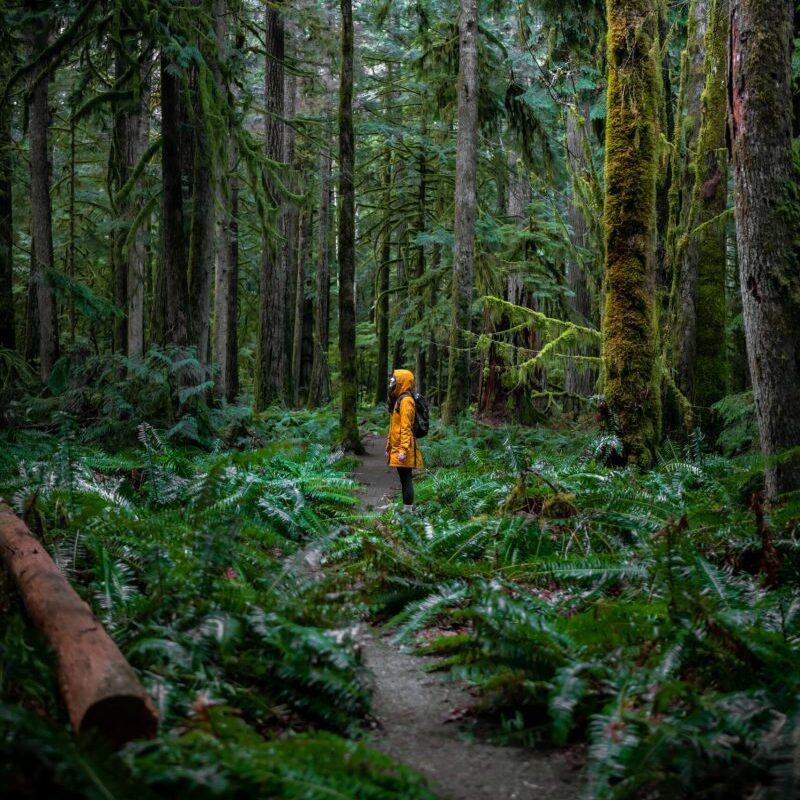Best Mountain Hikes In Olympic National Park – The most popular races in Olympic National Park are bucket list events, which draw huge crowds in the summer months. However, most tours pass through the same wonderful place of diversity and provide a peaceful experience. The deer enter the old growth forest near the Queets River. Explore 300-year-old petroglyphs carved into sea stacks along the Pacific coast. And feel good about choosing the path of less. The expansion of tourist facilities helps support the sustainability of the park.
Although the routes mentioned below do not attract a lot of visitors, they can still be visited by many tourists during the summer season. To avoid the crowds, arrive at a quiet breakfast time or plan your trip during the week. Alternatively, visit in autumn and shoulder seasons when there are fewer people and the weather may be better.
Best Mountain Hikes In Olympic National Park

Visiting these trails requires the vehicle to have an Olympic National Park Pass, except for the Bogachiel Rainforest River Trail, which requires a Northwest Forest Pass.
Top 10 Day Hikes On The Olympic Peninsula
Starting at the campground and Sol Duc Hot Springs, this limited tour explores both the wild banks of the Sol Duc River and the old forest area. In the middle, a bridge crosses the river, providing the best platform to watch the four streams of Sol Duc Falls plunge into the deep green valley. This is a great guide to the popular Marymere Falls route to the north. Travelers can camp or tour with a National Park Pass.
Also known as the Cape Alava Loop, this tour is an alternative to the famous Ruby, Shi Shi, and the ever popular Rialto Beach. Although Ozette is still popular, it is remote and difficult to get to, so it is less crowded and there is rarely a problem with parking.
This long, smooth hike has a little something for everyone: tidepools and the beach stacks of Wedding Rocks, rainforests, a road through licorice fern and salal understory, and more. Visitors to the coastal area can see 300-500 year old petroglyphs left by the ancestors of the Makah Tribe. Please respect the environment and do not disturb the petroglyphs. During high tide, visitors should be prepared to walk headfirst.
Near the Forks, about halfway between Ruby Beach and Kalaloch Lodge, you’ll find Beach 4. Make sure you visit at low tide, because it’s one of the best places in Olympic National Park to go snorkeling. Sea 4’s rocky outcroppings include purple sea stars, limpets, and giant green anemones, among other marine life. The road is signed to Highway 101 and has a parking lot. The fifteen-mile hike up the coast includes switchbacks and rock scrambling. Then it’s another quarter mile to get to the lakes, which makes the hike a mile longer compared to the full half mile just walking the trail.
How To Visit Olympic National Park (budget Guide!)
Many people climb Storm King Mountain to get to the top, but nearby is a small Pyramid Road that goes up to the top of the Pyramid. The summit offers equally stunning views of the surrounding mountains and Crescent Lake Cobalt. Hikers climb 2,400 feet in 3.5 miles to the WWII site. Although Pyramid Mountain is the highest point near Port Angeles and can be climbed all year round, the terrain makes the crossing dangerous during the rainy season. Even in the spring, extreme caution is advised in entering 100 yards past a landslide.
15 minutes south of Port Angeles, this trail climbs 2,300 feet in 3.5 miles to Lake Angeles, a teardrop-shaped basin. The path passes through a shallow forest covered with ferns. When hikers reach the lake at an altitude of 4,200 meters above sea level, there are good picnic spots. Look out for mountain goats on the cliffs above the sea. Due to its easy access, this place can see a lot of people in the summer. Come winter, the trail turns into a plowed trail, and this hike becomes a snow trail with few users.
To extend this trail into a 12.5 mile loop with 4,750 feet of elevation gain, continue south on the trail past Lake Angeles and connect to the Klahhane Ridge Trail. The route follows the spine of the valley northward past alpine meadows, basalt outcrops, and mountainous terrain. This loop is a fun option for a weekend return trip. If you choose backpacking, make sure you bring a backpacking permit.

Fewer visitors make the trip to the Queets River on the northwest side of the park, about an hour’s drive from Lake Quinault. Here, Sam’s River Loop begins at the Queets ranger station. This flat route overlooks the quiet areas of the rainforest below the Queets River. Watch for spawning fish on the sidelines while moose feed under giant Sitka-spruce, alder, and hemlock. Travelers will also pass through the ruins of ancient buildings.
Olympic National Park Vs Mount Rainier National Park: Ultimate Guide
Starting at the Quinault Ranger Station, the ADA-accessible Maple Glade Nature Loop explores wetlands and Kestner Creek. This trail snakes through tall spikemoss-covered forests and is a great trailhead to the once-popular and crowded Hoh River Trail. At the top of the trail, we distributed an information booklet explaining the nature of the forest. For more distance, hike the Kestner Homestead, a long loop, which connects to the Pleasant Maple Nature Trail. The trail explores much of the Kestner Creek forest, and homesteads from the 1800s.
This road takes the car to the north bank of the Bogachiel river. Although the trail starts in a small part of the forest, it eventually enters the tropical forests of the Hoh and Quinault valleys. In summer, the waters of Bogachiel are active and support the production of steel. Along its shore, a small bank of salmonberry beckons black bears and surfers alike. There are a number of river crossings, which can be difficult in winter. At 6 miles, there is a transition point at the Snider-Jackson intersection. After that, the trail continues 18 miles to the Mink Lake Trail Junction, but the trail past the Snider-Jackson junction is unmaintained and will require advanced hiking skills. Because this hike starts outside the park boundaries, you need a Northwest Forest Pass.
A pass is required to enter the park. It’s $30 for private, non-commercial vehicles, $25 for motorcycles, or $15 each for pedestrians and bicyclists. The pass is valid for seven consecutive days, and discounted passes are available for certain groups. If you want to camp, you need to buy certain permits.
Currently the most popular time to hike in Olympic National Park is spring. Go on a weekday or early morning for less crowds. On the other hand, the late spring and early fall seasons are quieter and offer better weather. Winter is the off season and can be the perfect time to explore the most popular hiking trails, fall and all.
Best Hikes In Olympic National Park & Olympic Peninsula, Wa
Olympic Hiking Co is a local hiking company outside of Port Angeles with a passion for adventure and adventure. They do private and group tours, as well as multi-day backpacking trips. However, Olympic National Park rangers host free, day-long interpretive tours and camping programs throughout the summer. Check their calendar for dates and times.
Hiking the trails in Olympic National Park helps break the wear and tear on visitors and sets a sustainable path for outdoor travel. In addition, receiving No Trace Certification is an important way to respect wilderness and natural areas. Follow No Trace guidelines including leave what you find, take what you find, and respect wildlife.
Popular trails include Hurricane Hill, Storm King, Marymere Falls, Devil’s Punchbowl, Sol Duc Falls, Hall of Mosses, Hole-in-the-Wall, High Divide, Five Mile Island by Hoh River Trail, and the Staircase Rapids Loop .

Ellee Thalheimer is a freelance writer and guidebook author based in the Pacific Northwest who has contributed to publications such as Lonely Planet Guidebooks, Please Be Friendly Outside and Exercise Leave No Trace. Learn more about how to apply the Leave No Trace principles to your next outdoor adventure here.
How To Drive Deer Park Road In Olympic National Park: The Complete Guide — Dirty Shoes & Epic Views
Finding a way to see more of Olympic National Park can be confusing for the first-time visitor. With nearly a million acres of parkland to explore and four beautiful and diverse natural areas, there’s plenty to see. While many people choose to backpack in the far reaches of the park (with good permits), there are plenty of easy day or moderate rides that show what makes the Olympics one of its gems. Pacific Northwest.
Here are 10 trends you shouldn’t miss. Some are short enough that they can be combined with others for a great day of exploring. And many, if you choose, can upgrade to a round trip or a long day trip in the area.
Located in the coastal and mid-water part of Olympic National Park, these loops take you to the beach and surrounding forest. Cape Alava is rich in petroglyphs and indigenous artifacts
Olympic mountain hikes, hikes in olympic national park, best family hikes in olympic national park, olympic national forest hikes, olympic national park day hikes, best overnight hikes in olympic national park, hikes near olympic national park, best short hikes in olympic national park, best olympic national park hikes, best winter hikes in olympic national park, best day hikes in olympic national park, best hikes in olympic national park

